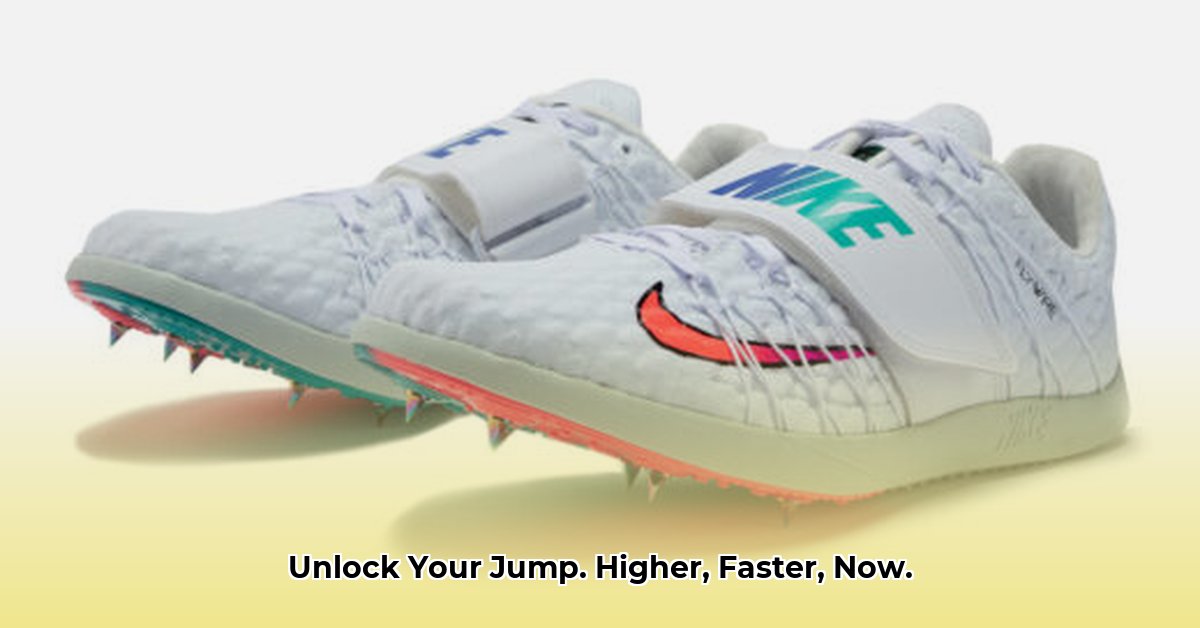Want to jump higher? Picking the right high jump spikes is key! This guide will walk you through everything you need to know, from understanding the different parts of a spike to finding the perfect fit. Whether you’re a pro or just starting out, we’ll help you choose the best spikes for your needs and keep them in top shape. We’ll even share some tips and tricks from experienced jumpers and coaches. Let’s get you soaring!
High Jump Spikes: A Detailed Overview for Enhanced Performance
So, you’re serious about high jumping? Fantastic! But before you even think about soaring over the bar, let’s talk about the unsung heroes of your performance: your high jump spikes. These aren’t just any old shoes; they’re precision-engineered tools designed to help you reach new heights (literally!). Choosing the right pair can significantly impact your jump – the wrong ones can actually hold you back. Let’s dive in and find the perfect fit for you and boost your high-performance footwear.
Understanding Your High Jump Spikes: More Than Just Shoes for Maximum Height Potential
Think of your high jump spikes as an extension of your body, a crucial link in the chain that converts your power into upward momentum. Unlike running shoes or even long jump spikes, high jump spikes have a unique design, specifically tailored for the demands of the high jump. That means the way the spikes are positioned, the amount of cushioning, and the stiffness of the sole are all meticulously considered to maximize your performance. Getting this right can make a huge difference to propel yourself over personal bests.
Key Features: What Makes High Jump Spikes Special for Optimum Performance?
Several key design elements distinguish high jump spikes from other track and field footwear:
-
Strategic Spike Placement: Unlike other track spikes, you’ll notice that high jump spikes have spikes positioned not just under the ball of your foot, but also strategically placed under your heel. This special arrangement helps you smoothly transition from your run-up to your powerful takeoff. It’s all about efficiency and transfer of energy. Having spikes at the front of the shoe allows for speed, and having spikes on the heel allows for stability.
-
Cushioning Considerations: The cushioning in your high jump spikes needs to strike a delicate balance. You want enough cushioning to absorb the impact of landing, protecting your joints, but not so much that it slows down your jump. Too much cushioning and you’ll lose that explosive power. It’s a very fine line!
-
Plate Rigidity: Finding the Right Stiffness: The midsole plate (the hard part under your foot) is also crucial. It needs to be firm enough to give you the stability you need for that powerful takeoff, but flexible enough to allow your foot to move naturally. A too-rigid sole might restrict your movement, while a too-flexible one might not provide enough support.
Many manufacturers employ different technologies to get this balance just right. They use materials like Pebax, known for its lightweight and flexible properties, or carbon fiber plates for increased stiffness and energy return. Spend some time researching different brands and their technologies; you’ll find a lot of interesting stuff out there and ensure a solid platform.
Types of High Jump Spikes: Finding Your Fit and Boosting Performance
High jump spikes are often categorized by weight, material, and cushioning:
-
Lightweight Spikes: These are all about speed and responsiveness. They’re generally favored by lighter and more experienced jumpers who prioritize a quick, powerful takeoff. However, they might not offer as much cushioning or stability.
-
Medium-Weight Spikes: This is often considered the “goldilocks” option – a good balance of cushioning, responsiveness, and support. Many jumpers find these versatile enough for their needs for enhanced flexibility.
-
Heavier Spikes: These spikes provide more protection and stability. They are often preferred by heavier jumpers who might need the extra support, but might sacrifice some speed and agility.
It’s really important to remember that the “best” type depends on your individual characteristics. Your weight, experience level, and personal preferences all play a role in the overall success and performance.
Choosing Your Perfect Spikes: A Personalized Approach for Optimum Results
Selecting the perfect high jump spikes is a bit like finding the perfect pair of jeans – it’s all about the fit! Here’s a step-by-step guide to help you make the right choice and reach new performance heights:
-
Skill Level Matters: Beginners may find more stability beneficial, often provided in heavier spikes. More experienced athletes, on the other hand, might prefer lighter, more responsive models to maximize their power, giving them a significant performance upgrade.
-
Know Your Foot: Consider your foot type. Do you have high arches, flat feet, or something in between? The right fit will accommodate your foot shape, preventing discomfort and blisters and ensuring alignment. Wider feet need wider shoes, while narrow feet need narrower ones for the shoe’s longevity.
-
Budget Wisely: High-quality spikes can range in price from affordable beginner models to high-end professional spikes. Setting a realistic budget before you start shopping will help you avoid impulse buys and focus on finding the right spikes within your means, enhancing the buying power.
-
Try Before you Buy (If Possible): Nothing beats trying on a pair of spikes to see how they feel. If possible, visit a track and field specialty store where you can try on different models and even take a few practice jumps.
Fitting Your Spikes: Get the Perfect Fit for Maximum Comfort and Performance
Proper fitting is crucial for both performance and injury prevention. Follow these steps for optimal comfort and support:
-
Length: Leave about a half-inch of space between your longest toe and the end of the spike. This space allows for your toes to move naturally during the jump, maximizing mobility.
-
Width: Your feet should fit comfortably inside the shoe, without feeling squeezed or constricted. Avoid shoes that are too narrow or too wide to unlock the true potential of the shoe’s build.
-
Heel Cup Security: The heel should be snug but not too tight. A secure heel cup prevents slippage during the run-up and jump, improving your stability for optimum jump power.
If you’re unsure, visiting a specialty running store for a professional fitting is a great idea. They’re experts at this, and can help you find the perfect fit, enhancing peak performance.
Maintaining Your High Jump Spikes: Keeping Them in Top Shape
Just like any piece of athletic equipment, your spikes need care and attention. Here’s how to keep them performing at their best and ensure that they last:
-
Regular Cleaning: Clean mud and debris immediately after each use to prevent damage and maintain hygiene, ensuring durability and maintenance. A simple brush and some water usually does the trick and unlocks their true potential.
-
Proper Storage: Store your spikes in a cool, dry place to prevent damage from moisture. Avoid leaving them in direct sunlight or extreme temperatures, maximizing the shoe’s lifespan.
-
Spike Replacement: Replace worn-out spikes promptly. Using damaged spikes is risky – it can increase your chance of injuries, reducing the chances of physical damage. Many spikes come with a spike wrench for easy replacement.
-
Check for Wear and Tear: Regularly inspect your spikes for any signs of wear and tear, such as cracks in the sole or tears in the upper. Addressing these issues early can prevent more significant damage.
Conclusion: Reaching New Heights and Mastering Your Jumping Potential
Choosing the right high jump spikes is a significant investment in your athletic success. By carefully considering the factors we’ve discussed – spike placement, cushioning, rigidity, your own individual needs and preferences – you can significantly improve your performance and jump higher than ever before. Remember, the right pair of spikes isn’t just about comfort; it’s about unlocking your full potential. So, get out there, find your perfect fit, and reach for those new personal bests with the right shoe choice!
Key Takeaways:
- Spike selection significantly impacts high jump performance as it raises the overall performance potential.
- Cushioning and plate stiffness are crucial factors for optimum jumps.
- Consider your skill level, foot shape, and budget for personalized results.
- Proper fitting prevents injuries and enhances performance by increasing alignment potential.
- Regular spike maintenance extends their lifespan as more spikes are added.
Understanding High Jump Spike Design for Improved Jumps
High jump spikes aren’t one-size-fits-all. They’re meticulously engineered for specific needs. Think of them as specialized tools – the right hammer for the right nail. How to choose the best track spikes for different jumping events based on cushioning and plate stiffness begins with understanding these key components as the core foundation:
-
Spike Plate: This is the foundation. Stiffer plates provide more energy transfer for powerful take-offs, as performance relies on plate quality. Softer plates offer more shock absorption, crucial during landings. Materials like nylon or carbon fiber influence the rigidity and the overall quality of the jumps.
-
Cushioning: This protects your feet and joints from impact. More cushioning equals more comfort but potentially less energy return, resulting in a less effective jump. Less cushioning gives direct feedback from the track but might increase injury risk. Finding the right balance is key for overall quality and results.
-
Spike Placement and Length: The number and placement of spikes influence traction, increasing the performance potential. High jumpers generally use fewer, strategically placed spikes for optimal grip and stability during
- Doctor Work Life Balance: Proven Strategies for Physician Well-being - November 20, 2025
- Find Your Work-Life Harmony: Quotes for a Fulfilling Life - November 18, 2025
- CRNA Work-Life Balance: Strategies for a Healthier Lifestyle - November 16, 2025
















